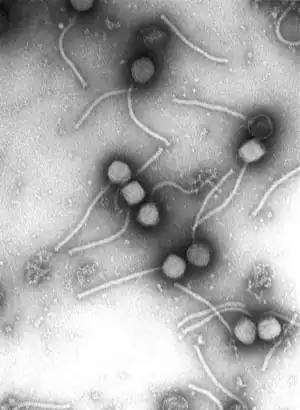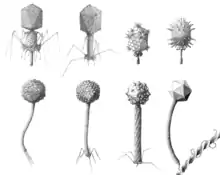Caudovirales
Caudoviricetes is a class of viruses known as the tailed bacteriophages (cauda is Latin for "tail").[1] Under the Baltimore classification scheme, the Caudoviricetes are group I viruses as they have double stranded DNA (dsDNA) genomes, which can be anywhere from 18,000 base pairs to 500,000 base pairs in length.[2] The virus particles have a distinct shape; each virion has an icosahedral head that contains the viral genome, and is attached to a flexible tail by a connector protein.[2] The order encompasses a wide range of viruses, many containing genes of similar nucleotide sequence and function. However, some tailed bacteriophage genomes can vary quite significantly in nucleotide sequence, even among the same genus. Due to their characteristic structure and possession of potentially homologous genes, it is believed these bacteriophages possess a common origin.[2]
| Caudoviricetes | |
|---|---|
 | |
| Different morphologies of tailed phages | |
| Virus classification | |
| (unranked): | Virus |
| Realm: | Duplodnaviria |
| Kingdom: | Heunggongvirae |
| Phylum: | Uroviricota |
| Class: | Caudoviricetes |
| Subdivisions | |



There are 4 orders, 47 families, 98 subfamilies, 1197 genera, 3601 species in the class. This makes Caudoviricetes the most populous class among viruses, accounting for approximately 30% of all recognized virus species and nearly half of all virus genera.[3]
Infection
Upon encountering a host bacterium, the tail section of the virion binds to receptors on the cell surface and delivers the DNA into the cell by use of an injectisome-like mechanism (an injectisome is a nanomachine that evolved for the delivery of proteins by type III secretion). The tail section of the virus punches a hole through the bacterial cell wall and plasma membrane and the genome passes down the tail into the cell. Once inside the genes are expressed from transcripts made by the host machinery, using host ribosomes. Typically, the genome is replicated by use of concatemers, in which overlapping segments of DNA are made, and then put together to form the whole genome.[2]
Assembly and maturation
Viral capsid proteins come together to form a precursor prohead, into which the genome enters. Once this has occurred, the prohead undergoes maturation by cleavage of capsid subunits to form an icosahedral phage head with 5-fold symmetry. After the head maturation, the tail is joined in one of two ways: Either the tail is constructed separately, and joined with the connector, or the tail is constructed directly onto the phage head. The tails consist of helix based proteins with 6-fold symmetry. After maturation of virus particles, the cell is lysed by lysins, holins, or a combination of the two.[2]
Basis for Taxonomy
For most of virological history, Caudoviricetes which was known as the order Caudovirales, had lower taxa defined via morphology and contractile ability of their "tails". The Myoviridae had long tails that were contractile; the Podoviridae had short noncontractile tails; and the Siphoviridae had long noncontractile tails.[4] Siphoviridae constitute the majority of the known tailed viruses.[2][5]
Bradley referred to what was known as the Myoviridae as type A, Siphoviridae as type B, and the Podoviridae as type C. He also divided his groups on the basis of head morphology: Within group A, A1 have small isometric heads; A2 have prolate heads; and A3 have elongated heads. Within groups B and C, numbers were similarly assigned: B1 and C1 have small isometric heads; B2 and C2 have prolate heads; and B3 and C3 have elongated heads.
Because the "families" Myoviridae, Podoviridae and Siphoviridae were abolished for being polyphyletic, there are now many free-floating families, subfamilies, and genera in the class without any preceding taxa before Caudoviricetes. There are currently 7 orders, 63 families, 109 subfamilies, 1360 genera, and 4079 species in the class. This article lists all official and proposed taxa of Caudoviricetes. (Note: Quotes means that the taxon is proposed and has not yet been ratified by the ICTV.)
Orders
- Crassvirales Order
- Crevaviridae Family
- Coarsevirinae Subfamily
- Doltivirinae Subfamily
- Intestiviridae Family
- Churivirinae Subfamily
- Crudevirinae Subfamily
- Obtuvirinae Subfamily
- Steigviridae Family
- Asinivirinae Subfamily
- Suoliviridae Family
- Bearivirinae Subfamily
- Boorivirinae Subfamily
- Loutivirinae Subfamily
- Oafivirinae Subfamily
- Uncouvirinae Subfamily
- Dechshavirus Unassigned Genus
- Crevaviridae Family
- Juravirales
- Kirjokansivirales
- Magrovirales
- Methanobavirales
- Nakonvirales
- Thumleimavirales
Etymology
Crassvirales infects bacteria and is named after the computer program crAss, which was used to identify the first member of the Crassvirales order.[6][7]
The rest (including the proposed orders) infect archaea. Kirjokansivirales, Thumleimavirales, and Nakonvirales are named after mythological objects or deities; Methanobavirales and Magrovirales are named after archaic synonyms of the archaea they infect.
Unassigned Taxa
Bacteriophage evolution
Bacteriophages occur in over 1100 bacterial or archaeal genera.[3] Over 6300 bacteriophages have been examined in the electron microscope since 1959. Of these, more than 96 percent have tails. Of the tailed phages, about 57 percent have long, noncontractile tails ("Siphoviridae"). Tailed phages appear to be monophyletic and are the oldest known virus group.[5][8]
See also
References
- Ackermann HW (1998). Tailed bacteriophages: the order caudovirales. pp. 135–201. doi:10.1016/S0065-3527(08)60785-X. ISBN 9780120398515. PMC 7173057. PMID 9891587.
{{cite book}}:|journal=ignored (help) - "Double-Stranded DNA Bacteriophages". Boundless. 2017-11-11. Archived from the original on 2013-06-28.
- "Virus Taxonomy: 2021 Release". International Committee on Taxonomy of Viruses (ICTV). March 2021. Retrieved 11 May 2021.
- Maniloff J, Ackermann HW (1998). "Taxonomy of bacterial viruses: establishment of tailed virus genera and the order Caudovirales". Archives of Virology. 143 (10): 2051–63. doi:10.1007/s007050050442. PMID 9856093. S2CID 34921877.
- Ackermann HW (May 2003). "Bacteriophage observations and evolution". Research in Microbiology. 154 (4): 245–51. doi:10.1016/S0923-2508(03)00067-6. PMID 12798228.
- Turner, Dann; et al. (2023). "Abolishment of morphology-based taxa and change to binomial species names: 2022 taxonomy update of the ICTV bacterial viruses subcommittee". Archives of Virology. 168 (2): 74. doi:10.1007/s00705-022-05694-2. PMC 9868039. PMID 36683075.
- "ICTV proposal Download".
- Ackermann HW, Prangishvili D (October 2012). "Prokaryote viruses studied by electron microscopy". Archives of Virology. 157 (10): 1843–9. doi:10.1007/s00705-012-1383-y. PMID 22752841. S2CID 16699662.
Further reading
- Xu J, Hendrix RW, Duda RL (October 2004). "Conserved translational frameshift in dsDNA bacteriophage tail assembly genes". Molecular Cell. 16 (1): 11–21. doi:10.1016/j.molcel.2004.09.006. PMID 15469818.
- Casjens SR (August 2005). "Comparative genomics and evolution of the tailed-bacteriophages". Current Opinion in Microbiology. 8 (4): 451–8. doi:10.1016/j.mib.2005.06.014. PMID 16019256.